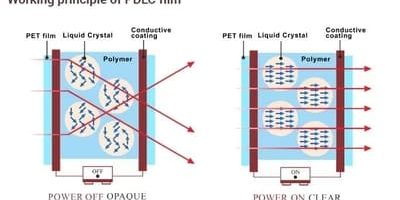This is an excellent question, and the trend is very real. The price of PDLC (Polymer Dispersed Liquid Crystal) film has dropped significantly over the past several years.
Here’s a breakdown of the key reasons why PDLC film has become so much cheaper.
1. Economies of Scale and Market Growth
This is the single biggest factor.
- Increased Production: As smart glass and switchable film technology gained popularity, manufacturers scaled up their production lines. Building and operating a large, automated factory is far more cost-efficient per unit than running a small, lab-like pilot plant.
- Raw Material Costs: The demand for the core raw materials—the liquid crystals, polymers, and conductive layers (like ITO and its alternatives)—has skyrocketed. Bulk purchasing by large manufacturers drives down the price of these inputs.
- Global Competition: A decade ago, only a handful of specialized companies made PDLC film. Today, there are numerous manufacturers, especially in Asia, competing fiercely on price and quality. This competition is a powerful driver for lower consumer prices.
2. Technological Maturation and Process Optimization
The “how” of making PDLC film has become more refined and less wasteful.
- Improved Manufacturing Processes: The techniques for uniformly dispersing liquid crystals in the polymer and creating consistent, large-roll films have been perfected. Higher production yields (less waste from defective film) directly lower the cost.
- Standardization: The recipe and process are no longer a black art. This standardization makes production faster, more reliable, and less prone to expensive errors.
3. Material Innovations and Cost-Reduction
Engineers have found cheaper ways to achieve the same or better performance.
- Alternatives to ITO: Indium Tin Oxide (ITO) is a highly effective transparent conductor, but indium is a rare and expensive metal. Significant R&D has led to the development of cheaper alternatives like:
- Silver Nanowires
- Conductive Polymers (e.g., PEDOT:PSS)
- Carbon Nanotubes / Graphene
- Metal Meshes
While ITO is still common, the existence and improvement of these cheaper alternatives put downward pressure on its price and offer lower-cost options.
- Optimized Formulations: The precise “cocktail” of liquid crystals and polymers has been optimized to use materials more efficiently without sacrificing performance (clarity, switching speed, power consumption).
4. Simplified and Cheaper Supporting Electronics
A PDLC film isn’t useful without a power supply (controller). The cost of these components has also plummeted.
- Mass-Produced Controllers: The AC inverters needed to power the film are now mass-produced, often using standard, inexpensive electronic components.
- Integration with Smart Systems: The ability to control the film with simple remotes, apps, or smart home systems has become a commodity feature rather than a costly custom integration.
5. Market Education and Reduced “Novelty Premium”
When PDLC was a new, high-tech novelty, companies could charge a premium simply because it was “magic.” Today, it’s a recognized building material with understood applications and limitations.
- Increased Awareness: Architects, designers, and consumers now know what it is. This reduces the marketing and education cost for suppliers.
- Price Transparency: With many suppliers listing prices online, it’s easier for buyers to compare, forcing sellers to be more competitive.
A Quick Analogy: The Flat-Screen TV
The price drop of PDLC film is very similar to what happened with flat-screen televisions.
- Early 2000s: A large plasma or LCD TV cost over $10,000. It was a luxury item made in limited quantities with new, expensive technology.
- Today: You can buy a larger, higher-quality 4K LED TV for a few hundred dollars. This is due to mass production, technological improvements, fierce global competition, and cheaper materials.
PDLC film has followed the exact same trajectory from a specialty product to a commoditized, mass-market item.
The Bottom Line:
The combination of mass production, technological refinements, material innovations, and intense global competition has transformed PDLC film from an expensive luxury into an increasingly affordable and accessible technology for residential and commercial projects. While still more expensive than traditional options like blinds or curtains, the price gap has narrowed dramatically, making its unique benefits (space-saving, modern aesthetic, on-demand privacy) available to a much wider audience.






